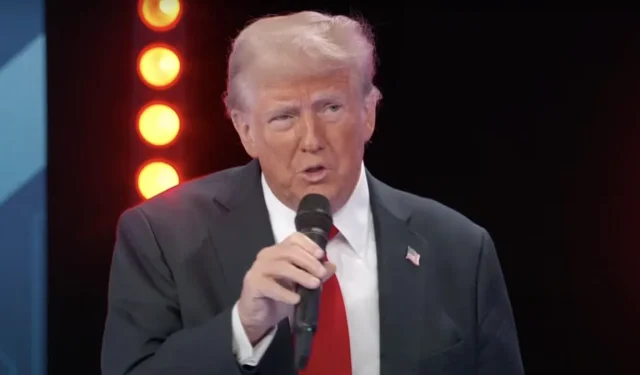
During a recent town hall Q&A, Donald Trump maintained his stance on unfounded allegations concerning Haitian migrants in Springfield, Ohio, supposedly consuming residents’ pets. This baseless assertion was first made by Trump during his debate with Kamala Harris in September, where he claimed that Haitian migrants were “eating the pets of the people that live there.”Despite numerous fact-checks that have debunked this claim, Trump refuses to acknowledge any error.
The former president’s recent town hall aimed to engage with issues relevant to Hispanic voters, covering a range of topics. One attendee, identifying as a registered Republican yet undecided, raised concerns about conspiracy theories pervading this electoral season. He directly asked Trump whether he still believed the claims about Haitian immigrants eating pets, receiving a vague and evasive response from Trump instead.
Trump attempted to deflect responsibility for propagating these rumors by responding, “I was just saying what was reported.” He argued that these claims were “in the newspapers and reported pretty broadly,” although it’s notable that they gained traction largely due to his initial remarks in the debate. Additionally, he implied that Haitians were “eating other things too that they’re not supposed to be,” yet he provided no further context, examples, or credible sources to validate his assertions.
This conspiracy theory has been thoroughly discredited. The idea of migrants consuming pets originates from debunked social media posts that referenced events unrelated to the Haitian immigrant community and were never substantiated by evidence in Springfield. Even Ohio’s Republican Governor, Mike DeWine, stated there was “no credible evidence” supporting Trump’s alarming assertions here.
While Trump continues to cling to this false narrative, his campaign partner, JD Vance, has also reinforced these claims. “The American media totally ignored this stuff until Donald Trump and I started talking about cat memes,” Vance stated in a September CNN interview. He added, “If I have to create stories so that the American media actually pays attention to the suffering of the American people, then that’s what I’m going to do.”
Although Trump reiterated his claims during the Q&A, his explanation was overly lengthy and included numerous inaccuracies about the immigration situation in Springfield. He inaccurately asserted that Springfield has a population of 50,000, recently inundated by 32,000 Haitian immigrants. Trump claimed that this population surge was overwhelming hospitals and schools, all the while said to be burdensome on residents’ ability to pay rent and purchase groceries.
However, as has been typical of Trump’s rhetoric, his numbers are far from accurate. While he guessed the city’s population is close, Springfield actually hosts around 58,000 residents. The overall immigrant population—including all nationalities—is estimated to be between 12,000 and 15,000 across Clark County, an area with a total population of 136,000.
Not only did Trump claim that Springfield’s number of migrants exceeds those in the entire county, but his portrayal of their influence is also grossly exaggerated. Haitian immigrants are not inflicting the negative consequences Trump asserts. In fact, ten new businesses have recently sprouted up in the city, founded by Haitian immigrants, while Governor DeWine has characterized these newcomers as “very hard workers.” Furthermore, crime statistics indicate no spike connected to the migrants; in fact, of the 199 inmates in Clark County jails, only two are Haitian.
Trump’s assertions lack any factual support, and it is frustrating to witness his defense that he is merely “reporting” what others have stated. His relentless propagation of falsehoods creates a harmful cycle—he spreads misinformation, which media outlets then report, allowing him to reference that reporting as a source. JD Vance’s comments about “creating stories” that capture media attention further illustrate that, in the absence of real issues, fabricating narratives may be the only way to incite public discourse.
(Featured image: Univision Noticias/YouTube)




Leave a Reply